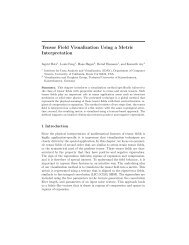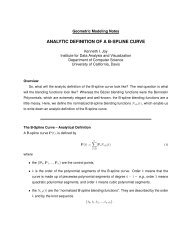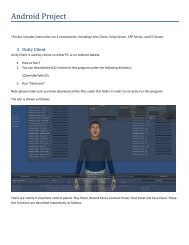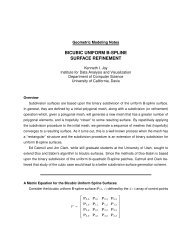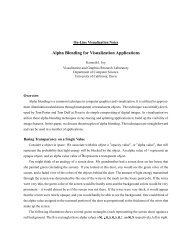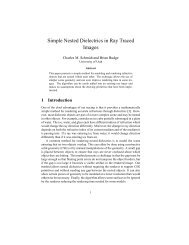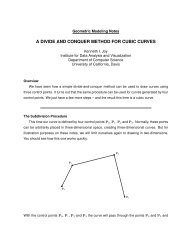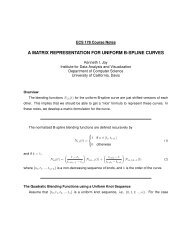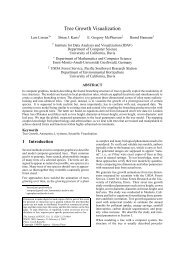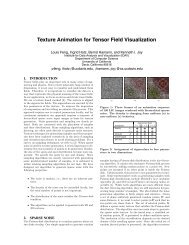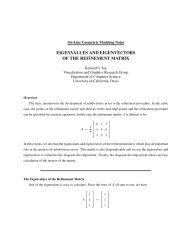Paper - IDAV: Institute for Data Analysis and Visualization
Paper - IDAV: Institute for Data Analysis and Visualization
Paper - IDAV: Institute for Data Analysis and Visualization
Create successful ePaper yourself
Turn your PDF publications into a flip-book with our unique Google optimized e-Paper software.
8 · Lefohn, Kniss, Strzodka, Sengupta, <strong>and</strong> Owens// Bind array to shaderCGparameter param = cgGetNamedParameter(prog, "array");array.bind_<strong>for</strong>_read( param );// ... Bind shader <strong>and</strong> render ...✝The type of the array is declared to be addressed by 4D integers <strong>and</strong> store 4D float values 1 . Glift adds template supportto Cg <strong>and</strong> so the array type of the parameter to the Cg shader must be instantiated with cgInstantiateParameter.Next, the array is defined <strong>and</strong> initialized; then lastly, the array is bound as a shader argument using bind <strong>for</strong> read.This is analogous to binding a texture to a shader, but binds the entire Glift structure.The Cg shader that reads from the 4D Glift array is as follows:✞☎float4 main( uni<strong>for</strong>m VMem4D array, varying float4 coord ) : COLOR {return array.vTex4D( coord );}✝✆This is st<strong>and</strong>ard Cg syntax except the array is declared as an abstract 4D type <strong>and</strong> array.vTex4D replaces native Cgtexture accesses. Note that all Glift components are defined in the C++ namespace glift; however, all subsequentcode examples in this paper exclude explicit namespace scoping <strong>for</strong> brevity.3.1 Physical MemoryThe PhysMem component encapsulates a GPU texture. It is most often instantiated by specifying an address type <strong>and</strong>value type. These address <strong>and</strong> value types are statically-sized, multidimensional vectors. For example, the PhysMemcomponent <strong>for</strong> the 4D array example is declared to use 2D integer addressing (vec2i) <strong>and</strong> store 4D float values(vec4f) as follows:✞☎typedef PhysMemGPU PhysMemType;✝✆Just as the STL containers have many default template parameters that are effectively hidden from most users,Glift components have optional template parameters <strong>for</strong> advanced users. If left unspecified, Glift uses type inferenceor default values <strong>for</strong> these extra parameters. In addition to the address <strong>and</strong> value type, PhysMem components arealso parameterized by an addressing mode <strong>and</strong> internal <strong>for</strong>mat. The addressing mode is either scaled (integer) ornormalized (floating point) <strong>and</strong> is specified using a Glift type tag 2 . The internal <strong>for</strong>mat is the OpenGL enumerant <strong>for</strong>the internal texture <strong>for</strong>mat. The complete template specification <strong>for</strong> a PhysMem component is:✞☎typedef PhysMemGPU PhysMemType;✆In the 4D array example, type inference determines the addressing mode to be ScaledAddressTag <strong>and</strong> theinternal <strong>for</strong>mat to be GL RGBAF32 ARB.✆3.2 Virtual MemoryIn the 4D array example, the virtual domain is four dimensional <strong>and</strong> the physical domain is two dimensional. Thegeneric VirtMem Glift component is parameterized by only the physical memory <strong>and</strong> address translator types:✞typedef VirtMemGPU VirtMemType;✝☎✆1 Note that the C++ code in this paper uses vector types such as vec4f to indicate statically-sized tuples of either integers or floats. In this case,vec4f indicates a tuple of four floats. In the future, Glift will accept user-defined vector/tuple classes that con<strong>for</strong>m to a minimal interface.2 Type tags are like C/C++ enumerants, but are more flexible <strong>and</strong> scalable <strong>for</strong> use in generic libraries.ACM Transactions on Graphics, Vol. 25, No. 1, January 2006.



